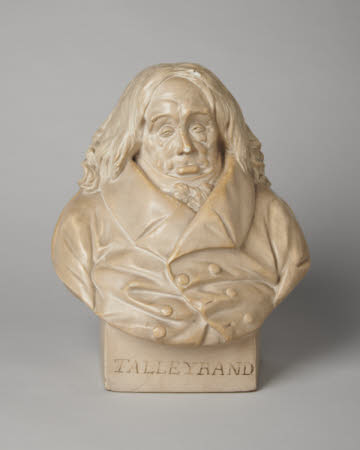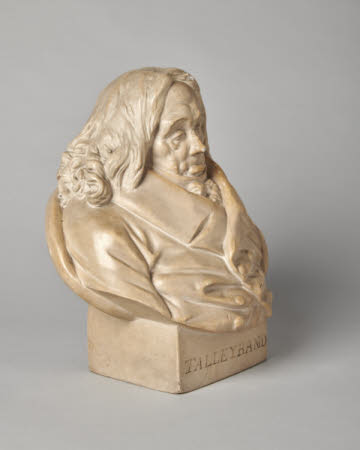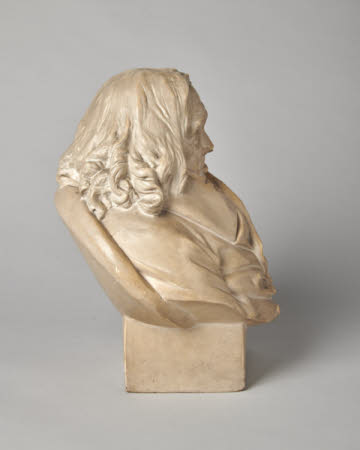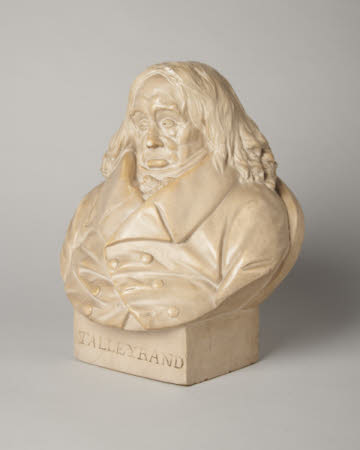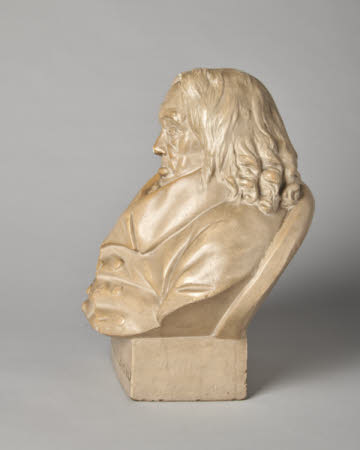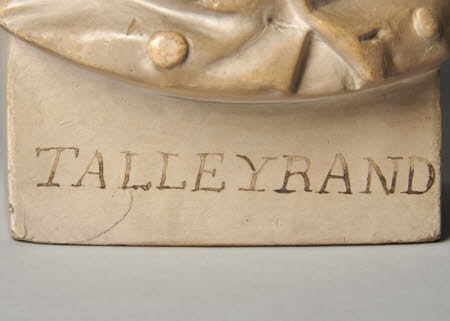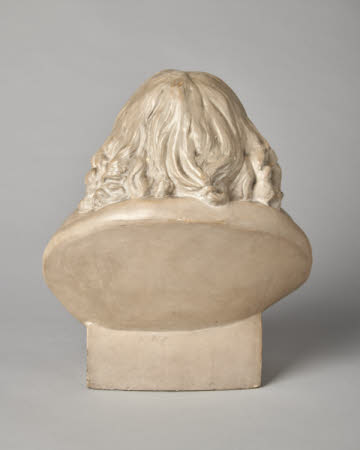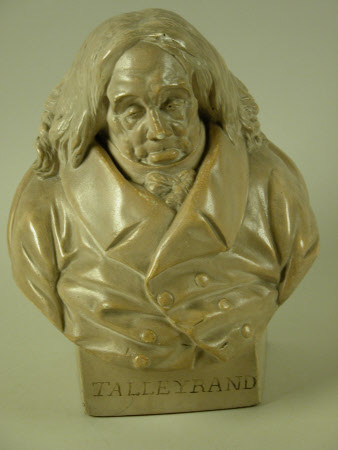Portrait bust of Talleyrand (Prince Charles Maurice de Talleyrand-Périgord, Prince of Benevento, 1754-1838)
Jean-Pierre Dantan (Paris 1800 - Baden-Baden 1869)
Category
Art / Sculpture
Date
24 Jul 1833
Materials
Plaster
Measurements
305 x 280 x 216 mm
Place of origin
London
Order this imageCollection
Mount Stewart, County Down
NT 1221043
Summary
Sculpture, patinated plaster; Prince Charles Maurice de Talleyrand-Périgord, Prince of Benevento (1754-1838) ; Dantan jeune (Jean-Pierre Dantan, 1800-1869) ; 1833. A caricature statuette of Talleyrand, the French diplomat and man of affairs who served twice as ambassador to Great Britain, in 1792 and then in in 1830-34. One of a group of seven such caricatures, known in French as ‘portraits chargés’ or ‘charges’, made by the French sculptor and satirist Dantan jeune during his first stay in London in 1833, brought to Mount Stewart from Londonderry House.
Full description
A portrait chargé or satirical portrait of Talleyrand, Prince Charles Maurice de Talleyrand-Périgord, Prince of Benevento (1754-1838), showing the subject at bust length, in a thick overcoat, partly buttoned up. He has long straggling hair and pendulous and gross features, his chin disappearing into his collar. Set on an integral rectangular socle, inscribed on the front TALLEYRAND, with the signature and date incised on the back. A portrait of an astonishing survivor, who began his public career under the ancien regime, then served successively the revolutionary authorities, the emperor Napoleon, the restored Bourbon monarchs and finally King Louis-Philippe. Talleyrand began his career as a clergyman, becoming a diplomat and being sent on missions to London in 1792. Later that year he left France again, just missing the Terror, living at first in Britain and then in the United States. On his return to France he became a close supporter of Napoleon Bonaparte and served as his foreign minister, but he became disillusioned and turned against the Emperor as he realised the delusion of Napoleon's imperial ambitions. Talleyrand was an important player at the Congress of Vienna, making a secret treaty with Castlereagh and Metternich against Russian expansion. Talleyrand played an important role in the restoration of the Bourbon monarchy following Napoleon’s final defeat at Waterloo in 1815, and thereafter he became an elder statesman. Between 1830 and 1834 he again lived in London, serving as Ambassador of France to the United Kingdom. At the time of this portrait Talleyrand was 76 years old. Dantan had observed Talleyrand at a party at the French Embassy, sitting in an armchair. He caught the elderly statesman’s corpulent state with the flesh of his face sagging, his chin disappearing into his collar and his lower lip protruding. As a satire, it is not perhaps one of Dantan’s most successful works, as Talleyrand himself recognised, when he commented that ‘It is too much a portrait, and too little a satire’ (‘C’est trop comme portrait; c’est trop peu comme charge’ Viro 1863, p. 90). Nevertheless it has been described as one of Dantan’s most beautiful charges and one of his finest psychological studies (Sorel 1989). The sculpture is one of a group of seven satirical statuettes by Dantan jeune at Mount Stewart (NT 1221043-1221049), all made during the sculptor’s first visit to London in 1833. They consist of five British subjects, mostly politicians: Duke of Wellington; Earl of Sefton; Earl of Eldon; Samuel Rogers and Lord Brougham; and two well-known Frenchmen resident in London at the time, the diplomat Talleyrand and the comte d’Orsay. Dantan jeune (Jean-Pierre Dantan, 1800-1869) was a successful portrait sculptor, but he became famous, especially during the decade of the 1830s, for his satirical sculptures, which he called Portraits chargés (‘loaded portraits’) or simply charges. For more information on Dantan and his work, see NT 1221044. Satirists had more opportunity for freedom of expression in Britain than in France, and Dantan’s British portraits chargés have been described as some of the most original and caustic of his caricatures (Sorel 1989, p. 32) and ‘as savage in treatment as any of his works’ (Seligman 1957, p. 75). During the 1830s his work was hardly less popular in London than it was in France, and he had some distinguished patrons, including the Fourth Marquess of Londonderry (1805-1872), who is thought to have acquired the group of statuettes at Mount Stewart. They were found in the house in the early twentieth century and taken to Londonderry House in London, where they were displayed in the Library. They returned to Mount Stewart after the sale and demolition of Londonderry House in 1962. Jeremy Warren April 2022
Provenance
Probably acquired by Frederick Stewart, 4th Marquess of Londonderry (1805-1872); by descent at Mount Stewart and Londonderry House; given to the National Trust by Lady Mairi Bury (1921-2009) in 1976.
Marks and inscriptions
Back of base, incised: : Published by/ Dantan 24/ Jul 1833 London Front of base, in ink:: TALLEYRAND
Makers and roles
Jean-Pierre Dantan (Paris 1800 - Baden-Baden 1869), sculptor
References
Londonderry House 1939: A Catalogue and Valued Inventory of the Furniture and Works of Art at Londonderry House, Park Lane, W... Prepared for the purposes of insurance, with historical notes, by H. Clifford-Smith, 1939, p.142. Burlington Fine Arts Club: ‘Catalogue of a Collection of English Caricature, Winter 1931/1932’, London 1931, no. 203 Montgomery Hyde 1937 H. Montgomery Hyde, Londonderry House and its Pictures, London 1937, p. 18, Pl. IV. Hale 1940 : Richard Walden Hale, Dantan, jeune 1800-1869, and his satirical and other sculpture, especially his “portraits chargés’, Needham, Mass. 1940. Seligman 1957: Janet Seligman. Figures of fun: the caricature-statuettes of Jean-Pierre Dantan, London 1957., pp. 10, 76, 127, 144. Sorel 1986: Philippe Sorel, ‘Les Dantan du Musée Carnavalet. Portraits-charges sculptés de l’époque romantique’, Gazette des Beaux-Arts,, 107 (1986), pp. 1-38 and 87-102, p. 97, nos. 288-89. Sorel 1989: Philippe Sorel, ‘Dantan jeune. Caricatures et portraits de la société romantique’, exh. cat., Maison de Balzac, Paris 1989., p. 80, no. 13. Viro 1863: [Félix Andry} Charges et bustes de Dantan jeune. Esquisse biographique, dédiée à Méry, par le docteur Prosper Viro, Paris 1863, pp. 43, 83., 90.
